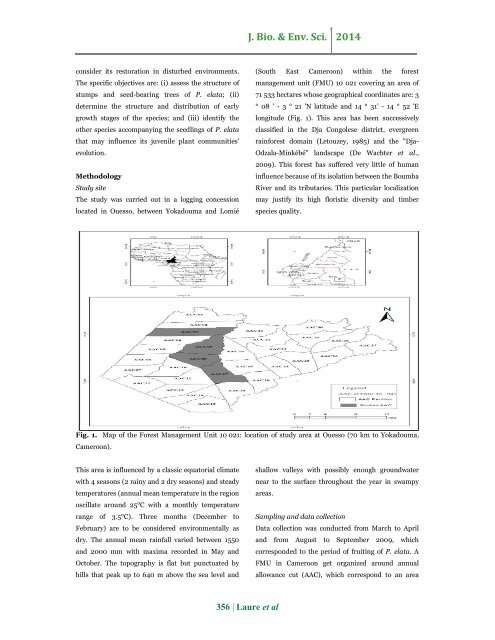Early growth stages structure and distribution of Pericopsis elata (Harms) van Meeuven in a logging concession of South – East Cameroon
Abstract Pericopsis elata (Harms) van Meeuwen is a tropical Africa's timber of high economic value. In many countries its low natural regeneration rate does not favor the replacement of harvested populations, thus CITES and IUCN recommended a total protection of the species. This survey aimed to characterize the early growth stages and natural regeneration of P. elata through the determination of seedlings distribution and structure. Squared plots of 2500 m² were installed around stumps and seed-bearing trees respectively in the logged and unlogged forest concessions at Ouesso, near Yokadouma, South-East Cameroon. Stumps, seed-bearing trees and seedlings were counted and their structural parameters (diameter and height) were recorded. A total of 56 plots corresponding to 14 ha were surveyed and 1069 seedlings were recorded. The rate of regeneration was 56% around stumps and 24.13% around seed-bearing trees. The spatial distribution of seedlings appears to be aggregated. Germination and seedling growth have shown that early growth stages of Pericopsis elata are not representing a relevant limiting factor for the evolution of population. However, the limited number of saplings and the lack of poles suggest that light could play and important role in the evolution of the early stages.
Abstract
Pericopsis elata (Harms) van Meeuwen is a tropical Africa's timber of high economic value. In many countries its low natural regeneration rate does not favor the replacement of harvested populations, thus CITES and IUCN recommended a total protection of the species. This survey aimed to characterize the early growth stages and natural regeneration of P. elata through the determination of seedlings distribution and structure. Squared plots
of 2500 m² were installed around stumps and seed-bearing trees respectively in the logged and unlogged forest concessions at Ouesso, near Yokadouma, South-East Cameroon. Stumps, seed-bearing trees and seedlings were counted and their structural parameters (diameter and height) were recorded. A total of 56 plots corresponding to 14 ha were surveyed and 1069 seedlings were recorded. The rate of regeneration was 56% around stumps and 24.13% around seed-bearing trees. The spatial distribution of seedlings appears to be aggregated. Germination and seedling growth have shown that early growth stages of Pericopsis elata are not representing a relevant limiting factor for the evolution of population. However, the limited number of saplings and the lack of poles
suggest that light could play and important role in the evolution of the early stages.
You also want an ePaper? Increase the reach of your titles
YUMPU automatically turns print PDFs into web optimized ePapers that Google loves.
J. Bio. & Env. Sci. 2014<br />
consider its restoration <strong>in</strong> disturbed environments.<br />
The specific objectives are: (i) assess the <strong>structure</strong> <strong>of</strong><br />
stumps <strong>and</strong> seed-bear<strong>in</strong>g trees <strong>of</strong> P. <strong>elata</strong>; (ii)<br />
determ<strong>in</strong>e the <strong>structure</strong> <strong>and</strong> <strong>distribution</strong> <strong>of</strong> early<br />
<strong>growth</strong> <strong>stages</strong> <strong>of</strong> the species; <strong>and</strong> (iii) identify the<br />
other species accompany<strong>in</strong>g the seedl<strong>in</strong>gs <strong>of</strong> P. <strong>elata</strong><br />
that may <strong>in</strong>fluence its juvenile plant communities'<br />
evolution.<br />
Methodology<br />
Study site<br />
The study was carried out <strong>in</strong> a logg<strong>in</strong>g <strong>concession</strong><br />
located <strong>in</strong> Ouesso, between Yokadouma <strong>and</strong> Lomié<br />
(<strong>South</strong> <strong>East</strong> <strong>Cameroon</strong>) with<strong>in</strong> the forest<br />
management unit (FMU) 10 021 cover<strong>in</strong>g an area <strong>of</strong><br />
71 533 hectares whose geographical coord<strong>in</strong>ates are: 3<br />
° 08 ' - 3 ° 21 'N latitude <strong>and</strong> 14 ° 31' - 14 ° 52 'E<br />
longitude (Fig. 1). This area has been successively<br />
classified <strong>in</strong> the Dja Congolese district, evergreen<br />
ra<strong>in</strong>forest doma<strong>in</strong> (Letouzey, 1985) <strong>and</strong> the "Dja-<br />
Odzala-M<strong>in</strong>kébé" l<strong>and</strong>scape (De Wachter et al.,<br />
2009). This forest has suffered very little <strong>of</strong> human<br />
<strong>in</strong>fluence because <strong>of</strong> its isolation between the Boumba<br />
River <strong>and</strong> its tributaries. This particular localization<br />
may justify its high floristic diversity <strong>and</strong> timber<br />
species quality.<br />
Fig. 1. Map <strong>of</strong> the Forest Management Unit 10 021: location <strong>of</strong> study area at Ouesso (70 km to Yokadouma,<br />
<strong>Cameroon</strong>).<br />
This area is <strong>in</strong>fluenced by a classic equatorial climate<br />
with 4 seasons (2 ra<strong>in</strong>y <strong>and</strong> 2 dry seasons) <strong>and</strong> steady<br />
temperatures (annual mean temperature <strong>in</strong> the region<br />
oscillate around 25°C with a monthly temperature<br />
range <strong>of</strong> 3.5°C). Three months (December to<br />
February) are to be considered environmentally as<br />
dry. The annual mean ra<strong>in</strong>fall varied between 1550<br />
<strong>and</strong> 2000 mm with maxima recorded <strong>in</strong> May <strong>and</strong><br />
October. The topography is flat but punctuated by<br />
hills that peak up to 640 m above the sea level <strong>and</strong><br />
shallow valleys with possibly enough groundwater<br />
near to the surface throughout the year <strong>in</strong> swampy<br />
areas.<br />
Sampl<strong>in</strong>g <strong>and</strong> data collection<br />
Data collection was conducted from March to April<br />
<strong>and</strong> from August to September 2009, which<br />
corresponded to the period <strong>of</strong> fruit<strong>in</strong>g <strong>of</strong> P. <strong>elata</strong>. A<br />
FMU <strong>in</strong> <strong>Cameroon</strong> get organized around annual<br />
allowance cut (AAC), which correspond to an area<br />
356 | Laure et al





![Review on: impact of seed rates and method of sowing on yield and yield related traits of Teff [Eragrostis teff (Zucc.) Trotter] | IJAAR @yumpu](https://documents.yumpu.com/000/066/025/853/c0a2f1eefa2ed71422e741fbc2b37a5fd6200cb1/6b7767675149533469736965546e4c6a4e57325054773d3d/4f6e6531383245617a537a49397878747846574858513d3d.jpg?AWSAccessKeyId=AKIAICNEWSPSEKTJ5M3Q&Expires=1717106400&Signature=8h8vT%2FfbukKTqBXKDVxJ6reT6Mo%3D)












